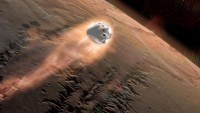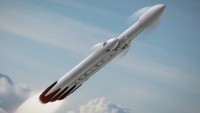SpaceX Reports to NASA on Progress in Mars Landing Project
| Arthur Dominic Villasanta | | Jun 24, 2016 05:00 AM EDT |
(Photo : SpaceX) Red Dragon over Mars
SpaceX has told NASA that work on its Dragon manned spacecraft; its Falcon 9 launch vehicle and ground operations development in support of its Mars mission are on track for a second quarter 2017 debut of the Dragon spacecraft.
The first Dragon launch with a human crew remains scheduled for the end of 2017. In a meeting with NASA, SpaceX outlined the steps it plans to take to land humans on Mars.
Like Us on Facebook
SpaceX Director of Space Operations Garrett Reisman said the company's success in safely landing the first stage of its Falcon 9 launch vehicle on robot barges in the ocean is the most visible aspect of the success of its overall effort to land spacecraft, robots then humans on Mars.
Because of this success, SpaceX has begun to have storage space issues at its Horizontal Integration Facility (HIF) at LC-39A at the Kennedy Space Center. This facility houses four of the Falcon 9 first stages that successfully re-landed from December 2015 to April 2016. A fifth landing in June ended in failure.
"We're really excited about what's happening with reusability because it will allow us to drastically reduce the cost of getting things into space, which will enable all kinds of new architectures," said Reisman.
SpaceX's goal of reusing Falcon 9's first stage is driven by the need to reduce the cost of space exploration, and the need to gain more experience in "propulsive landings." SpaceX will use propulsive landing to land its unmanned Red Dragon spacecraft on Mars in 2018.
"Earth's upper atmosphere is also a really good analogue for Mars' atmosphere," said Reisman. "When you get up high enough, the density and consistency of the atmosphere is very similar to what you face during Entry, Descent and Landing (EDL) on Mars.
"So every time we land, we take one of these rockets and we perform hypersonic retrograde propulsion, the data from which we're sharing with JPL because it's the first time this has ever been demonstrated on a major scale."
He said the Falcon 9 first stage landings are really test beds for the EDL systems of eventual Mars missions.
"Every time you see one of those rockets coming back, not only is it enabling a whole new paradigm for launching things into space, but it's also bringing us one step closer to Mars."
He said SpaceX is also heading toward a series of several major upcoming milestones to enable human flights on its Dragon spacecraft. One of these steps will be to build a flight-like capsule in which SpaceX will test the life-support systems it plans to install on its first Mars human landing mission set for 2025.
And, of course, there's the SpaceX spacesuit, said Reisman.
SpaceX will have to qualify its spacesuit (or make sure it's safe for astronaut use) in a series of solo tests and human tests.
"We're going to finish our spacesuits and qualify them, including vacuum chamber testing with suited human subjects."
This will then lead to the Flight Test Without Crew Certification Review. This is the final certification SpaceX needs to launch the Demo 1 uncrewed mission of the human-rated Dragon spacecraft in the second quarter of 2017.
Demo 1 will use the exact hardware, software and operations planned for use on crewed Dragon missions. It will give SpaceX and NASA a chance to see how all of the Dragon's life-support systems operate in an integrated fashion during actual flight.
Once the Demo 1 flight is complete, SpaceX will proceed forward with parachute qualification before performing an in-flight abort test. This in-flight abort test will demonstrate Dragon's ability to separate safely during the most difficult region of first-stage flight.
Once the in-flight abort test is complete, SpaceX will proceed to the Design Certification Review and the Flight Test Readiness Review, the final review before the Demo 2 crewed flight in late 2017. Demo 2 is a re-flight of the Demo 1 mission, except it will carry a crew this time around.
"This will mark, hopefully, the first time that we restore the capability of launching people to space from America," said Reisman about Demo 2.
Once Demo 2 is complete, SpaceX will perform the Operations Readiness Review before the final Certification Review (CR) with NASA. Once NASA accepts the CR, SpaceX will be granted permission to launch up to six Post Certification Missions with humans to the International Space Station.
And then, it's on to Mars.
TagsSpaceX, NASA, Dragon, Mars landing, Falcon 9, Garrett Reisman
©2015 Chinatopix All rights reserved. Do not reproduce without permission
EDITOR'S PICKS
-

Did the Trump administration just announce plans for a trade war with ‘hostile’ China and Russia?
-

US Senate passes Taiwan travel bill slammed by China
-

As Yan Sihong’s family grieves, here are other Chinese students who went missing abroad. Some have never been found
-

Beijing blasts Western critics who ‘smear China’ with the term sharp power
-

China Envoy Seeks to Defuse Tensions With U.S. as a Trade War Brews
-

Singapore's Deputy PM Provides Bitcoin Vote of Confidence Amid China's Blanket Bans
-

China warns investors over risks in overseas virtual currency trading
-

Chinese government most trustworthy: survey
-

Kashima Antlers On Course For Back-To-Back Titles
MOST POPULAR
LATEST NEWS
Zhou Yongkang: China's Former Security Chief Sentenced to Life in Prison

China's former Chief of the Ministry of Public Security, Zhou Yongkang, has been given a life sentence after he was found guilty of abusing his office, bribery and deliberately ... Full Article
TRENDING STORY

China Pork Prices Expected to Stabilize As The Supplies Recover

Elephone P9000 Smartphone is now on Sale on Amazon India

There's a Big Chance Cliffhangers Won't Still Be Resolved When Grey's Anatomy Season 13 Returns

Supreme Court Ruled on Samsung vs Apple Dispute for Patent Infringement

Microsoft Surface Pro 5 Rumors and Release Date: What is the Latest?













